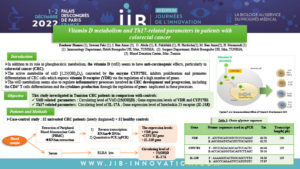Meilleur e-poster 2022 – Zouhour HAMZA – Sfax – Tunisie
Z. Hamza 1,*, S. Feki 1, I. Ben Amor 2, O. Abida 1, R. Fakhfakh 1,
H. Hachicha 1, M. Ben Amar 3, H. Masmoudi 1
Présenté par : Zouhour HAMZA, Sfax – Tunisie
Contextualisation
Several studies reported that the active metabolite of vitamin D (vitD) [1,25(OH)2D3] inhibits proliferation and promotes differentiation of Colorectal cancer (CRC) cells which express vitamin D receptor (VDR) via the regulation of a high number of genes. The vitD metabolism seems also to regulate inflammatory processes involved in CRC development and progression, including the CD4+ T cells differentiation and the cytokines production.
Objectifs
In this study, different VitD related-genes expression and Th17-related parameters were investigated in CRC patients in comparison with controls.
Méthodes
This is a case-control study which involved 35 untreated CRC patients and 35 healthy controls. The expression levels of VDR, CYP27B1 (encoding 1 α hydroxylase) and interleukin 23 receptor (IL23R) genes in peripheral blood mononuclear cells (PBMC) were studied using a quantitative PCR (qPCR). The measurement of circulating levels of VitD (25(OH)D) and IL17A was performed using ELISA kits.
Résultats obtenus ou attendus
As expected, the mean level of circulating 25(OH)D was significantly lower in CRC patients in comparison with controls(p=0.002). A statistically significant association was observed between VitD deficiency (25(OH)D < 20 ng/mL) and risk of CRC (odds ratio [OR] =3.18 ;IC 95% = 1.13 et 8.93; p=0.025). In contrary, the mean levels of VDR and CYP27B1 gene expression were significantly higher in patients than in controls (p<0.001; p=0.022, respectively). Regarding Th17 axis, the mean level of circulating IL17A was significantly higher in patients than in controls (p=0.03). The mean level of IL23R gene expression was higher in patients than in controls (p=0.66). The levels of 25(OH)D were inversely correlated with the circulating levels of IL17A (r = -0.34 ;p=0.03).
Discussion
VitD is reported to have several chemopreventive effects on CRC including direct anti-tumor mechanisms, the effects on the immune system, and gut microbiota modulation(E.Rinninella et al.2021).The high expression of the VDR and CYP27B1 genes in patients may be explained by the activation of CD4+ and CD8+ T cells(M.Bendix et al.2015).Regarding Th17 axis,the elevation of its parameters (IL17A levels + IL23R gene expression) in patients with CRC seems to be related to the inflammatory process in the tumor microenvironment(N.West et al.2015).Our results are in line with the findings of an experimental study which suggested that 1,25(OH)2D3downregulates IL-17Aexpressionin T cells(S.Joshi et al.2011).
Conclusion et perspectives
The vitD, by binding to its receptor (VDR), seems to regulate the expression of a high number of genes involved inCRC cell proliferation as well as T helper cell differentiation.Further clinical studies are required to confirm the close interplay between vitD, anti-tumor immunity, and CRC, suggesting a possible role of vitD as a potential agent in CRC prevention and therapy.






